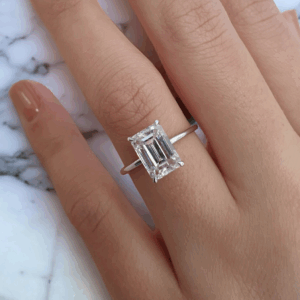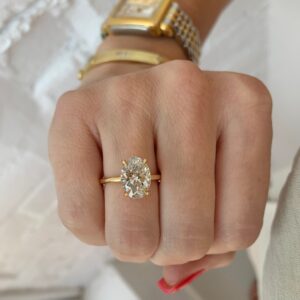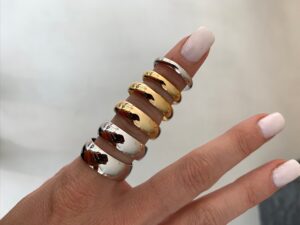
White Gold vs Yellow Gold: Key Differences in Color & Value
When it comes to selecting the perfect engagement ring or fine jewelry, one of the most common dilemmas is choosing between white gold vs yellow gold. Both metals offer unique aesthetics, durability, and price points, making it essential to understand their differences before making a purchase.
At Nature Sparkle, we don’t just sell engagement rings; we craft meaningful experiences. Our commitment to excellence ensures that every piece is meticulously designed to the highest standards. In this guide, we’ll walk you through the key aspects of gold color comparison, helping you determine which gold is better for your jewelry needs.
What is White Gold?
White gold is an alloy of pure gold mixed with white metals such as palladium, nickel, or silver. Since pure gold has a natural yellow hue, these alloy metals help create its signature silvery-white appearance. To enhance its brilliance and durability, white gold is coated with rhodium plating, which adds a lustrous sheen and protects it from scratches.

Characteristics of White Gold:
- Appearance: Bright, silvery-white with a reflective finish
- Composition: Gold alloyed with white metals
- Durability: Resistant to scratches, but rhodium plating may wear off over time
- Maintenance: Requires periodic rhodium re-plating to maintain its color
- Popularity: Often chosen for modern and sleek jewelry styles
Why Choose White Gold?
- Enhances Diamond Brilliance: The cool-toned metal enhances the brilliance of diamonds, making them appear larger and more radiant.
- More Affordable than Platinum: White gold offers a similar aesthetic to platinum but at a lower price point.
- Modern and Versatile: Complements various gemstones and is a popular choice for engagement rings.
What is Yellow Gold?
Yellow gold is the most traditional form of gold jewelry, made by mixing pure gold with alloy metals like copper and zinc. This composition gives it a warm, golden hue that has been cherished for centuries.

Characteristics of Yellow Gold:
- Appearance: Rich, warm golden color
- Composition: Gold alloyed with copper and zinc
- Durability: More resistant to tarnishing but prone to scratches and dents
- Maintenance: Requires regular polishing to maintain its luster
- Popularity: Classic and timeless, often used in vintage and traditional jewelry
Why Choose Yellow Gold?
- Timeless Appeal: Yellow gold has been used in jewelry for centuries and exudes a sense of tradition and elegance.
- Pairs Well with Warm-Toned Gemstones: Complements gemstones such as rubies, citrines, and warm-colored diamonds.
- Hypoallergenic: Unlike white gold, yellow gold doesn’t contain nickel, making it ideal for sensitive skin.
White Gold vs Yellow Gold: Key Differences
|
Feature | White Gold | Yellow Gold |
| Color | Silvery-white with rhodium plating |
Warm golden hue |
|
Composition | Gold mixed with white metals | Gold mixed with copper and zinc |
| Durability | More scratch-resistant but needs rhodium re-plating |
More prone to scratches and dents |
|
Maintenance | Requires re-plating every few years | Needs regular polishing |
|
Best For | Modern, sleek jewelry designs |
Classic, vintage, and traditional designs |
| Price Comparison | May cost slightly more due to rhodium plating |
Similar price, based on karat weight |
Durability: Which Gold Lasts Longer?
When considering white gold vs yellow gold, durability is a crucial factor. White gold is slightly more durable due to its rhodium plating, which adds extra strength and scratch resistance. However, this plating wears off over time and requires maintenance. Yellow gold, while resistant to tarnishing, is softer and more prone to scratches and dents.
Verdict:
If you’re looking for a low-maintenance option, yellow gold may be preferable. However, if you prefer a more durable and sleek option, white gold is the better choice.
Price Comparison: White Gold vs Yellow Gold
A white vs yellow gold price comparison often shows that both metals cost approximately the same if they have the same gold content. However, white gold may be slightly more expensive due to the additional rhodium plating required to maintain its color.
Verdict:
If you’re on a budget, both 14K white gold and 14K yellow gold will be similarly priced. If you prefer 18K gold, expect to pay more for either metal.
Hypoallergenic Properties: Which Gold is Safer for Sensitive Skin?
For individuals with sensitive skin, yellow gold is often the safer choice because it doesn’t contain nickel, which can cause allergic reactions in some people. White gold, especially lower-karat versions, may contain nickel unless labeled as nickel-free.
Verdict:
If you have metal allergies, opt for yellow gold or nickel-free white gold.
Which Gold is More Popular?
Both white and yellow gold have their own fan base:
- White gold is popular for modern and contemporary jewelry due to its sleek, platinum-like appearance.
- Yellow gold remains a classic favorite, especially for those who prefer traditional, vintage, or royal-inspired designs.
Verdict:
Your choice depends on your personal style! Go for white gold if you prefer a sleek, contemporary look, and yellow gold if you love a warm, vintage aesthetic.

Final Thoughts: White Gold or Yellow Gold?
When choosing between white gold vs yellow gold, consider your personal preferences, lifestyle, and maintenance preferences.
- If you love modern aesthetics, durability, and versatility, go for white gold.
- If you prefer classic, vintage appeal and a warm, rich tone, yellow gold is your best bet.
At Nature Sparkle, we offer a wide selection of white and yellow gold engagement rings crafted with precision and care. No matter your choice, you can rest assured that you’re investing in a timeless piece of jewelry.
Explore our collection today and find the perfect ring to symbolize your love!